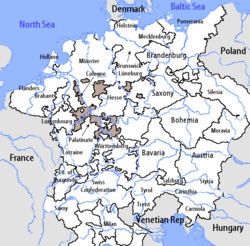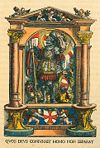Electoral Palatinate
|
|||||||||||||||||||||||||||||||||||||||||||||
The Palatinate of the Rhine (German: Pfalzgrafschaft bei Rhein), later the Electoral Palatinate (German: Kurpfalz), was a historical territory of the Holy Roman Empire, a palatinate administered by a count palatine. Its rulers served as prince-electors of the Holy Roman Empire from 1356.
The Electoral Palatinate was a much larger territory than what later became known as the Rhenish Palatinate (Rheinpfalz), on the west bank of the Rhine, and is now the contemporary region of the Palatinate in the German federal state of Rhineland-Palatinate. The Electoral Palatinate also included territory that lay on the east bank of the Rhine, containing the cities of Heidelberg and Mannheim.
Contents |
Counts Palatine of Lotharingia, 915–1085
The Palatinate emerged from the County Palatine of Lotharingia, which came into existence in the 10th century.
- Wigeric of Lotharingia, count of the Bidgau (c. 915/916–922)
- Godfrey, count of the Jülichgau (c. 940)
House of Ezzonen
During the 11th century, the Palantine was dominated by the Ezzonian dynasty, who governed several counties on both banks of the Rhine.
- Hermann I of Lotharingia, 945–994
- Ezzo of Lotharingia, 994–1034
- Otto I of Lotharingia, 1034–45 (Duke of Swabia 1045–47)
- Heinrich I of Lotharingia, 1045–61
- Hermann II of Lotharingia, 1061–85 (in tutelage to Anno II, archbishop of Cologne until 1064)
Counts Palatine of the Rhine, 1085–1356
From about 1085/1086, after the death of the last Ezzonian palatine count, Herman II of Lotharingia, the Palatinate lost its military importance in Lotharingia. The territorial authority of the count palatine was reduced to his counties along the Rhine, from then on called County Palatine of the Rhine.
- Heinrich II of Laach, 1085–95
- Sigfried of Ballenstadt, 1095–1113
- Gottfried of Kalw, 1113–29
- Wilhelm of Ballenstadt, 1129–39
- Henry IV Jasomirgott, 1139–42
- Hermann III of Stahleck, 1142–55
Hohenstaufen Counts Palatine
The first hereditary Count Palatine of the Rhine was Conrad of Hohenstaufen who was the younger brother of Emperor Frederick Barbarossa. The territories attached to this hereditary office started from those held by the Hohenstaufens in Franconia and Rhineland (other branches of the Hohenstaufens received Swabian lands, Franche-Comté, and so forth). Much of this was from their imperial ancestors, the Franconian emperors, and a part from Conrad's maternal ancestry, the Saarbrücken. These backgrounds explain the composition of Upper and Rhenish Palatinate in the inheritance centuries onwards.
- Conrad of Hohenstaufen 1156–95
Welf Counts Palatine
In 1195, the Palatinate passed to the House of Welf through the marriage of Agnes, heir to the Staufen count.
- Henry V of Welf, 1195–1213
- Henry VI of Welf, 1213–14
Wittelsbach Counts Palatine
In the early 13th century, with the marriage of the Welf heiress Agnes, the territory fell to the Wittelsbach Dukes of Bavaria, who were also dukes and counts palatine of Bavaria.
- Louis I, 1214–27
- Otto II, 1227–53
- Louis II (Duke of Upper Bavaria), 1253–94
During a later division of territory among the heirs of Duke Louis II of Upper Bavaria in 1294, the elder branch of the Wittelsbachs came into possession of both the Rhenish Palatinate and the territories in the Bavarian "Nordgau" (Bavaria north of the Danube river) with the centre around the town of Amberg. As this region was politically connected to the Rhenish Palatinate, the name Upper Palatinate (Oberpfalz) became common from the early 16th century in contrast to the Lower Palatinate along the Rhine.
- Rudolf I, 1294–1317
- Adolf, 1317–27
With the Treaty of Pavia in 1329, the emperor Louis IV, a son of Louis II, returned the Palatinate to his nephews Rudolf and Rupert.
- Rudolf II, 1329–53
- Rupert I, 1353–56
Electors Palatine, 1356–1777
In the Golden Bull of 1356, the Palatinate was recognized as one of the secular electorates, and given the hereditary offices of archsteward (Erztruchseß) of the Empire and imperial vicar (Reichsverweser) of Franconia, Swabia, the Rhine, and southern Germany. From that time forth, the Count Palatine of the Rhine was usually known as the Elector Palatine (Kurfürst von der Pfalz). The position as prince-elector had already existed earlier (for example, two rival kings of Germany were elected in 1257: Richard of Cornwall and Alfonso of Castile) though it is difficult to pinpoint any exact start of that office.
Due to the practice of dividing territories among different branches of the family, by the early 16th century junior lines of the Palatine Wittelsbachs came to rule in Simmern, Kaiserslautern, and Zweibrücken in the Lower Palatinate, and in Neuburg and Sulzbach in the Upper Palatinate. The Elector Palatine, now based in Heidelberg, adopted Lutheranism in the 1530s and Calvinism in the 1550s.
First Electorate, 1356–1648
| Wittelsbach dynasty | |||
| Image | Name | Date | Notes |
|---|---|---|---|
| Rupert I | 1356–1390 | As Rupert I above | |
| Rupert II | 1390–1398 | Nephew of Rupert I, son of Adolf | |
 |
Rupert III | 1398–1410 | Son of Rupert II, elected King of Germany in 1400 |
 |
Louis III | 1410–1436 | Son of Rupert III |
| Louis IV | 1436–1449 | Son of Louis III | |
 |
Frederick I | 1449–1476 | Brother of Louis IV |
 |
Philip | 1476–1508 | Son of Louis IV |
| Louis V | 1508–1544 | Son of Philip | |
 |
Frederick II | 1544–1556 | Brother of Louis V |
 |
Otto Henry | 1556–1559 | Nephew of Frederick II, son of Rupert of Freising |
| Line of Simmern | |||
| Image | Name | Date | Notes |
 |
Frederick III | 1559–1576 | When the senior branch of the family died out in 1559, the Electorate passed to Frederick III of Simmern, a staunch Calvinist, and the Palatinate became one of the major centers of Calvinism in Europe, supporting Calvinist rebellions in both the Netherlands and France. |
| Louis VI | 1576–1583 | Son of Frederick III | |
 |
Frederick IV | 1583–1610 | Son of Louis VI. With his adviser Christian of Anhalt, founded the Evangelical Union of Protestant states in 1608. |
 |
Frederick V | 1610–1623 | Son of Frederick IV and married to Elizabeth, daughter of James I of Great Britain. In 1619, he accepted the throne of Bohemia from the Bohemian estates. He was soon defeated by the forces of Emperor Ferdinand II at the Battle of White Mountain in 1620, and Spanish and Bavarian troops soon occupied the Palatinate itself. Called "the Winter King", because his reign in Bohemia only lasted one winter. In 1623, Frederick was put under the ban of the Empire. |
| House of Bavaria, 1623–48 | |||
| Image | Name | Date | Notes |
 |
Maximilian I of Bavaria | 1623–1648 (d. 1651) | Frederick V's territories and his position as Elector were transferred to the Duke of Bavaria, Maximilian I, of a distantly related branch of the House of Wittelsbach. Although technically Elector Palatine, he was known as the Elector of Bavaria. From 1648 he ruled in Bavaria and the Upper Palatinate alone, but retained all his Electoral dignities and the seniority of the Palatinate Electorate; see further Electors of Bavaria. |
Second Electorate, 1648–1777
| Restored Simmern Line | |||
| Image | Name | Date | Notes |
|---|---|---|---|
 |
Charles I Louis | 1648–1680 | Son of Frederick V. By the Peace of Westphalia in 1648, Charles Louis was restored to the Lower Palatinate, and given a new electoral title, also called "Elector Palatine", but lower in precedence than the other electorates. |
| Charles II | 1680–1685 | Son of Charles I Louis. Last of the Simmern line. | |
| Neuburg Line | |||
| Image | Name | Date | Notes |
 |
Philip William | 1685–1690 | In 1685, the Simmern line died out, and the Palatinate was inherited by Philip William, Count Palatine of Neuburg (also Duke of Jülich and Berg), a Catholic. |
 |
John William II | 1690–1716 | Son of Philip William |
 |
Charles III Philip | 1716–1742 | Brother of John William II. Last of the Neuburg line. Moved the capital of the Palatinate from Heidelberg to Mannheim in 1720. |
| Sulzbach Line | |||
| Image | Name | Date | Notes |
 |
Charles IV Theodore | 1742–1777 | The Palatinate was inherited by Duke Charles Theodore of Sulzbach. Charles Theodore also inherited the Electorate of Bavaria when its ruling line became extinct in 1777. |
Electors of Bavaria and Counts Palatine of the Rhine, 1777–1803
| Sulzbach Line | |||
| Image | Name | Date | Notes |
|---|---|---|---|
 |
Charles IV Theodore | 1777–1799 | The title and authority of Elector Palatine were subsumed into the Electorate of Bavaria, Charles Theodore and his heirs retaining only the single vote and precedence of the Bavarian elector. They continued to use the title "Count Palatine of the Rhine" (German: Pfalzgraf bei Rhein). |
| Zweibrücken Line | |||
| Image | Name | Date | Notes |
 |
Maximilian Joseph | 1799–1803 (d. 1825) | Charles Theodore's heir, Maximilian Joseph, Duke of Zweibrücken (on the French border), brought all the Wittelsbach territories under a single rule in 1799. The Palatinate was dissolved in the Wars of the French Revolution. First, its left bank territories were occupied, and then annexed, by France starting in 1795; then, in 1803, its right bank territories were taken by the Margrave of Baden. The Electoral Palatinate, as a distinct territory, disappeared. In 1806, the Holy Roman Empire was abolished, and all the rights and responsibilities of the electors with it. |
Later developments
In 1806, Baden was raised to a Grand Duchy. At the Congress of Vienna in 1814 and 1815, the left-bank Palatinate – enlarged by other regions such as the former bishopric of Speyer – was returned to the Wittelsbachs and became a formal part of the Kingdom of Bavaria in 1816 and after this time, it was this region that was principally known as the Palatinate. The area remained a part of Bavaria until after the Second World War, when it was separated and became a part of the new state of Rhineland-Palatinate, along with former left bank territories of Prussia and Hesse-Darmstadt.
External links
- (German) Heidelberg and the Palatine; elaborate information on history and architecture, illustrated with many pictures.
- (German) Virtual Library of the History of the Electoral Palatinate
|
||||||||||
|
|||||||||||||
|
||||||||||


